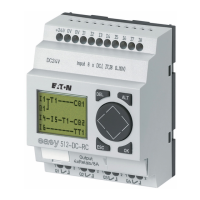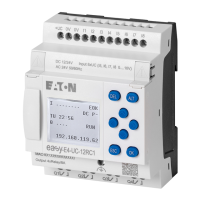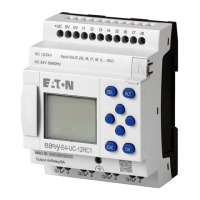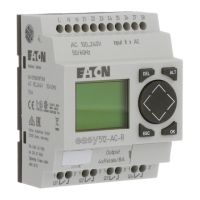1. easyE4 control relays description
1.2 Function
1.2.1 Features
l Logic gates
l Time and counter functions
l Time switch functions
l Arithmetic functions
l PID controllers
l Control relays with 16-character x 6-line LCD display (128 x 96 pixels) and keypad
available.
l Function expansions can be implemented with insertable microSD cards
l Integrated operating system, can be loaded
l Built-in Ethernet interface
l Requires little space; can be used in an upright position as well
l Device construction for mounting rails
l Programming languages: Ladder diagram (LD), Function Block Diagram (FBD),
Structured Text (ST), and easy Device Programming (EDP) on device and in
easySoft 7
easyE4 base devices combine the functions of a control relay and an input device in one
single unit
The Ethernet port makes it possible to integrate the base device into a network.
This allows the design of systems using high-speed controllers with decentralized intel-
ligence.
There is ladder diagram language version called easy Device Programming (EDP) that
you can use to put together a circuit diagram on the device.
In the case of devices with a display, you can enter the program as a circuit diagram dir-
ectly on the device by using the corresponding buttons. You can also program it on your
computer with the easySoft 7 programming software program (this option can also be
used for base devices without a display).
For example, you can:
l Connect N/O and N/C contacts in series and in parallel
l Connect output relays and markers.
l Define outputs as coils, impulse relays, rising
or falling edge-triggered relays or as latching relays.
l ...
You can use the function blocks to run arithmetic functions, compare values, count up,
count down, etc. All the function blocks available are provided in a list → Section "Func-
tion blocks", page 166
If you wish to wire a easyE4 device via your PC, i.e. create a circuit diagram, use the
easySoft 7→ Section "Programming software easySoft 7", page 28.
20
easyE4 11/18 MN050009 EN www.eaton.com
